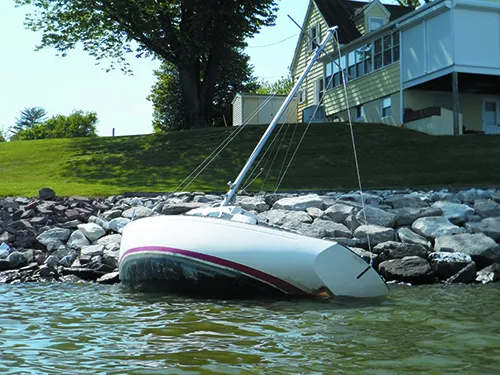
Unless you are a boatbuilder, repair boats for a living, or like messing around with a boat more than you like sailing, your first boat should probably not be a storm-damaged boat. The learn-as-you-go approach to boat restoration usually leads to some very expensive lessons.
Having restored a 31-foot Atkin gaff-rigged ketch that was liquidated from a boatyard in the late 1980s, I have a bit of experience. We bought the boat for $6,000, sunk at least five times that into it and sailed for 10 years, so it could be regarded as a success. The advantages of rebuilding your boat from the keel up are that you acquire the skills to be self-sufficient, and you truly know your boat inside and out.
Another success story was the 42-foot Endeavour Lost Boys, which served as a Practical Sailor test platform for several years. The owner, a boatbuilder, purchased her for $18,000 and invested another $40,000 in a refit (including a new diesel). If you ignore the many hours of labor, the boat sold for a profit five years later.
For the industrious sailor who has lots of time, a storm damaged boat can be an opportunity. Here, I’ll share five things to consider before going this route.
- Sistership Comparison. How much does a ship-shape sistership cost? Generally, if the storm damaged boat is not deeply discounted by 75 percent or much more, rethink the project. The used sailboat market is still soft, meaning there are many good bargain boats that are in ready-to-sail shape.
- The Essentials. Is the engine, rig, and essential structure – hull and deck—intact? If not, a long project is on the horizon. Look for boats with mostly cosmetic damage and no structural damage.
- DIY Assessment. Do you plan to do the work yourself, or hire labor? If you plan to do the work yourself, expect to spend a lot more time than you anticipated. The DIY restoration project often delays departures by months—or years.
- Pedigree Check. Is the boat worth restoring? If you aren’t in love with the boat, and it isn’t a highly sought-after cruiser, do you really want to pour so much time and money into it?
- Contingency Plans. Apart from the obvious damage, there are almost surely some hidden problems. If the boat was under saltwater, chances are you’ll not only need to rebuild or replace the engine, you’ll also need to rewire the boat—a tedious and expensive project.
An old adage says that there is nothing more expensive than a free boat, and that would apply to any storm salvage. But if you believe, as I do, that more rescued boats return to sea than don’t, then you have at least one good reason to take up the charge.



































